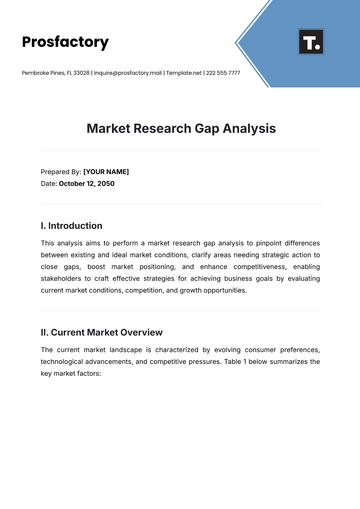Free Social Media Analysis

Prepared By : | [Your Name] |
Company : | [Your Company Name] |
Department : | [YOUR DEPARTMENT] |
Address: | [Your Company Address] |
Email: | [Your Company Email] |
Social Media: | [Your Company Social Media] |
Website: | [Your Company Website] |
I. Executive Summary
This section provides a brief overview of the key findings and insights derived from the social media analysis.
A. Objective
The objective of this analysis is to assess the effectiveness of our social media marketing efforts in increasing brand awareness and engagement.
B. Scope
The analysis encompasses an examination of data that has been gathered from social media platforms including Facebook, Twitter, and Instagram, spanning a period of the last six months.
C. Key Findings
Our engagement metrics have improved significantly across all platforms, with Instagram showing the highest growth in audience reach and interaction. Content related to product tutorials and user-generated content has performed exceptionally well. However, there is room for improvement in our Twitter engagement.
D. Recommendations
Enhance the visibility and engagement on your Twitter platform by increasing the frequency of your posts and concentrating on the creation of more interactive content that encourages and stimulates user participation and interaction.
II. Methodology
Outline the approach and techniques used to conduct the social media analysis.
A. Data Collection
Data was collected using social media analytics tools such as Hootsuite and Facebook Insights. We gathered metrics including likes, shares, comments, and audience demographics.
B. Data Analysis
The data that had been collected was subjected to a detailed analysis with the intent to discern any underlying trends, identify recurrent patterns, and pinpoint potential areas where improvements could be effectively implemented.
C. Tools Used
Hootsuite, Facebook Insights, Twitter Analytics, Instagram Insights.
III. Platform Performance Analysis
Evaluate the performance of each social media platform.
A. Facebook
Engagement Metrics: Average likes per post increased by 25%, shares by 30%, and comments by 15%.
Audience Demographics: The majority of our audience falls within the 25-34 age group, with a slight skew towards females.
Content Analysis: Video content received the highest engagement, particularly videos showcasing product features and customer testimonials.
B. Twitter
Engagement Metrics: While follower count increased, overall engagement remained stagnant. Retweets saw a slight decline.
Audience Demographics: Twitter's audience comprises a diverse age range, with a higher percentage of males compared to other platforms.
Content Analysis: Tweets with visual content, especially infographics, received higher engagement rates.
C. Instagram
Engagement Metrics: Experienced the highest growth in engagement, with likes increasing by 40% and comments by 50%.
Audience Demographics: The majority of followers are aged between 18-24, with a fairly even gender distribution.
Content Analysis: Posts featuring behind-the-scenes content and user-generated photos garnered the most engagement.
IV. Competitor Analysis
Compare the social media performance of key competitors.
A. Competitor 1
Engagement Metrics: Our engagement metrics surpass Competitor 1's across all platforms, indicating a stronger social media presence.
Content Strategy: Competitor 1 focuses heavily on promotional content, whereas we emphasize user-generated content and brand storytelling.
B. Competitor 2
Engagement Metrics: Competitor 2 has a higher follower count, but our engagement rates are comparable.
Content Strategy: They prioritize influencer collaborations, while we leverage customer testimonials to drive engagement.
V. Trend Analysis
Identify emerging trends and patterns in social media engagement.
A. Content Trends
Short-form video content is increasingly becoming popular across various social media platforms, with Instagram and Facebook experiencing particularly notable surges in the consumption and production of such content.
B. Audience Behavior
There is an increasing need for genuine and transparent communication from brands, and there is a positive reaction from users when they encounter content generated by other users.
C. Industry Insights
E-commerce brands are increasingly utilizing the features of social commerce to actively facilitate and boost direct sales by engaging customers directly through various social media platforms.
VI. Conclusion
Summarize the key takeaways from the social media analysis and reiterate recommendations.
A. Key Insights
Our social media efforts have yielded positive results in terms of increased engagement and brand visibility. However, there are opportunities to enhance our Twitter presence further and diversify content strategies.
B. Action Plan
Implement a revised content calendar with increased Twitter activity and a focus on interactive content formats. Monitor performance regularly and adjust strategies accordingly.
- 100% Customizable, free editor
- Access 1 Million+ Templates, photo’s & graphics
- Download or share as a template
- Click and replace photos, graphics, text, backgrounds
- Resize, crop, AI write & more
- Access advanced editor
Unlock insights with the Social Media Analysis Template from Template.net. This fully customizable and editable tool allows you to analyze social media metrics effortlessly. Editable in our Ai Editor Tool, this template is designed for seamless personalization, helping you make data-driven decisions with ease and precision. Transform your social media strategy today!





























